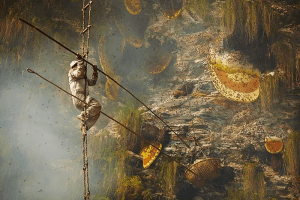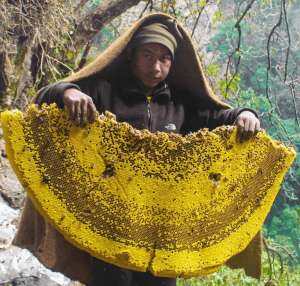Honey Hunting, an ancient tradition of harvesting wild honey from cliffs by fearless honey hunters. This unique and thrilling adventure can be experienced in regions like Lamjung and Myagdi, where Indigenous communities perform honey hunting in the most perilous conditions. Here’s a detailed look at this incredible tradition that has attracted tourists to Nepal and continues to be a symbol of bravery, skill, and cultural heritage. Nepal, a country of diverse landscapes and rich traditions, is home to many fascinating practices that continue to capture the imagination of visitors from around the world.

1. What is Honey Hunting?
Honey hunting refers to the process of collecting honey from wild bees that build their hives in the cliffs of the mountains, often hundreds of feet above the ground. Unlike conventional beekeeping, honey hunters in Nepal harvest honey from rocky cliffs where wild bees, particularly the giant honey bee (Apis dorsata), build their nests.
The practice is ancient, with deep spiritual and cultural significance. It has been passed down through generations, primarily in rural mountain areas, where the tradition continues to thrive as part of the Indigenous Magar and Gurung communities’ way of life. The hunters descend from the cliffs using a combination of ropes, ladders, and bamboo poles while balancing on narrow ledges, all while dealing with aggressive bee attacks.
2. Historical and Cultural Significance of Honey Hunting
Honey hunting is not only a means of livelihood but also a cultural ritual. The practice has been part of Nepalese folklore for centuries. Many communities hold spiritual beliefs around honey hunting, considering the bees as sacred beings that bless the hunters with a good harvest. There are various rituals and prayers performed before, during, and after the hunt to appease the gods and protect the hunters from danger.

The Magar and Gurung communities in regions like Lamjung and Myagdi have long been the custodians of this practice. The honey hunting process involves collective community effort, with hunters climbing and harvesting honey, while others manage safety, supply ropes, and pray for the safety of the hunters.
In some areas, honey hunting is a seasonal event and may even involve celebrations, dances, and feasts after a successful harvest.
3. How is Honey Harvested?
The process of honey hunting involves several stages:
- Preparation: Before embarking on the hunt, the community gathers to prepare their tools, which include ropes, bamboo poles, knives, and protective gear. Some communities also prepare traditional herbal remedies to soothe bee stings.
- Climbing the Cliff: Honey hunters, typically men, climb cliffs using a bamboo ladder or rope system. The ladders are carefully tied to trees or rocks, and the hunters scale the cliffs with remarkable agility.
- Harvesting Honey: Once the hunter reaches the hive, they carefully cut the honeycomb from the cliff face. The process involves quick and precise action, as the bees can become agitated and dangerous. The hunter fills the harvested honeycomb into baskets or bags and lowers it to the ground using ropes.
- Dealing with Bee Stings: One of the most dangerous aspects of honey hunting is the risk of bee stings. The hunters often endure painful stings, but they are well-prepared to manage the situation with herbal remedies and protective clothing made from thick materials.
- Celebration and Sharing: After a successful harvest, the honey is shared among the community. The honey is prized not only for its sweetness but also for its medicinal properties, and it is often used in rituals, medicines, and traditional foods.
4. Regions Where Honey Hunting Takes Place
The most famous locations for honey hunting in Nepal are found in the Lamjung and Myagdi districts, both located in the western part of the country. These regions, known for their rugged landscapes and cliffs, provide the perfect environment for wild honey bees to thrive.
- Lamjung: Lamjung, located near the Annapurna Conservation Area, offers some of the most picturesque and adventurous honey-hunting experiences. The cliffs here are often home to large Apis dorsata colonies, and local hunters still perform their time-honored methods of harvesting honey.
- Myagdi: Myagdi is another hotspot for honey hunting, particularly in villages like Beni and Darbang, where tourists can witness the incredible bravery of the honey hunters scaling dizzying heights to collect wild honey.
Both of these regions are accessible from Pokhara, which is a major tourist hub in Nepal. Travelers can visit these districts either by bus or jeep from Pokhara, with a trek up to the honey hunting sites.
5. Honey Hunting as a Tourist Attraction
Honey hunting is now a major eco-tourism and adventure tourism attraction in Nepal. Tourists from around the world come to watch this fascinating tradition firsthand, either by participating in the hunt (under the supervision of locals) or by witnessing the process from a safe distance.
Here’s why honey hunting attracts tourists:
- Unique Cultural Experience: Honey hunting offers a rare glimpse into a centuries-old tradition that has been passed down through generations. It’s an opportunity to witness the bravery and ingenuity of the local communities and to immerse in their customs and rituals.
- Adventure Tourism: The adrenaline-pumping aspect of the honey hunt—climbing perilous cliffs and harvesting honey from dangerous heights—appeals to adventure seekers looking for something beyond traditional trekking in Nepal.
- Ecotourism: Tourists can support local economies by purchasing honey directly from the honey hunters, contributing to the conservation of both the local culture and the environment.
- Photographic Opportunity: The dramatic cliffs, the lush landscapes, and the intense process of honey hunting offer amazing photo opportunities for travelers.
6. How to Experience Honey Hunting as a Tourist
If you’re planning to experience honey hunting, here are some steps to help you organize your trip:
- Best Time to Visit: Honey hunting typically takes place in the spring and autumn seasons, particularly from March to May and September to November. During these months, the bees are most active, and the weather is favorable for climbing.
- Guides and Local Tour Operators: Many local tour companies offer packages that include honey hunting tours. These tours will often include a trek to the honey hunting site, interaction with local honey hunters, and a chance to witness or even participate in the harvesting process.
- Safety: Always go with a certified guide or tour company. Although It is exhilarating, it can be dangerous, and experienced guides ensure that you remain safe.
7. Conclusion
Honey hunting is not only an ancient tradition but also a living heritage that continues to thrive in the rugged hills of Lamjung and Myagdi. The bravery and resourcefulness of the honey hunters, coupled with the striking beauty of the cliffs and the surrounding landscape, make this experience a must-see for anyone visiting Nepal. Whether you’re an adventure seeker, a cultural enthusiast, or simply someone looking to experience something unique, It offers a thrilling and authentic experience that you won’t find anywhere else.


